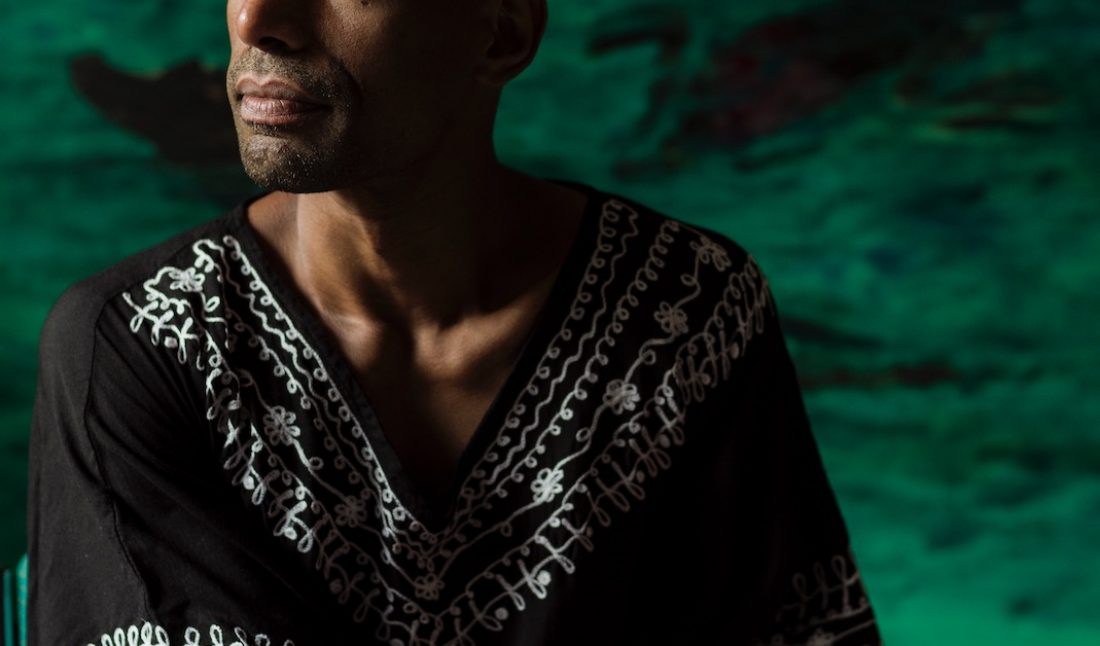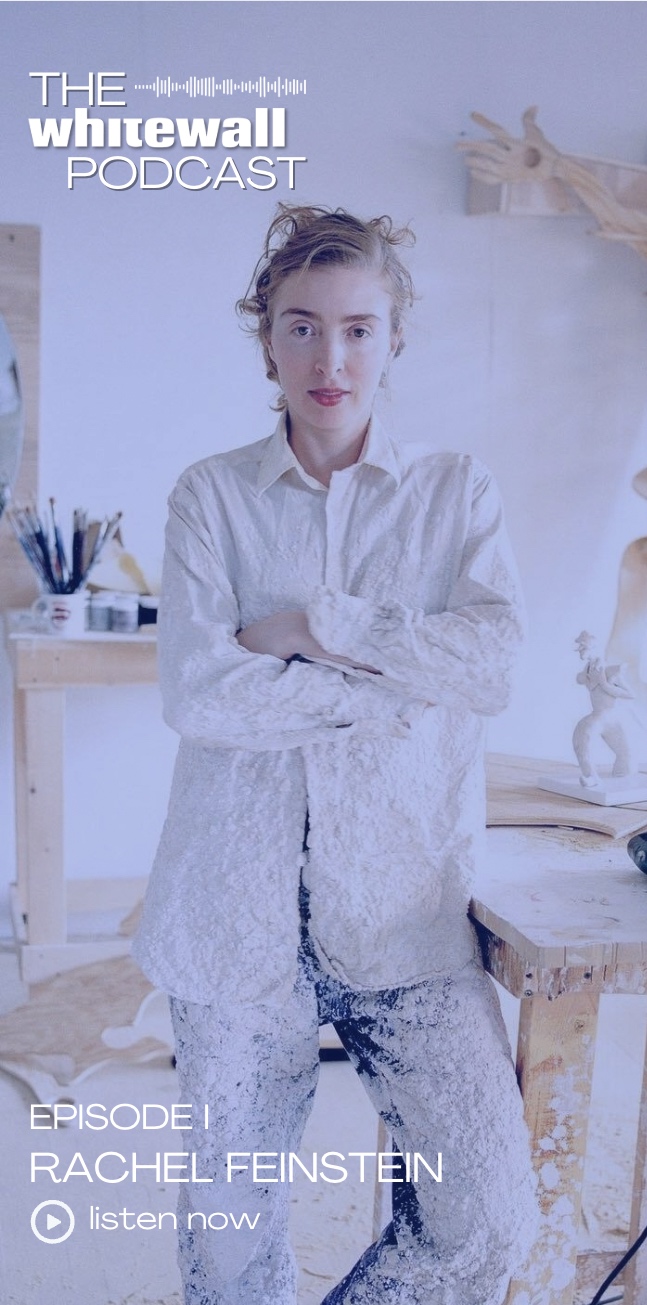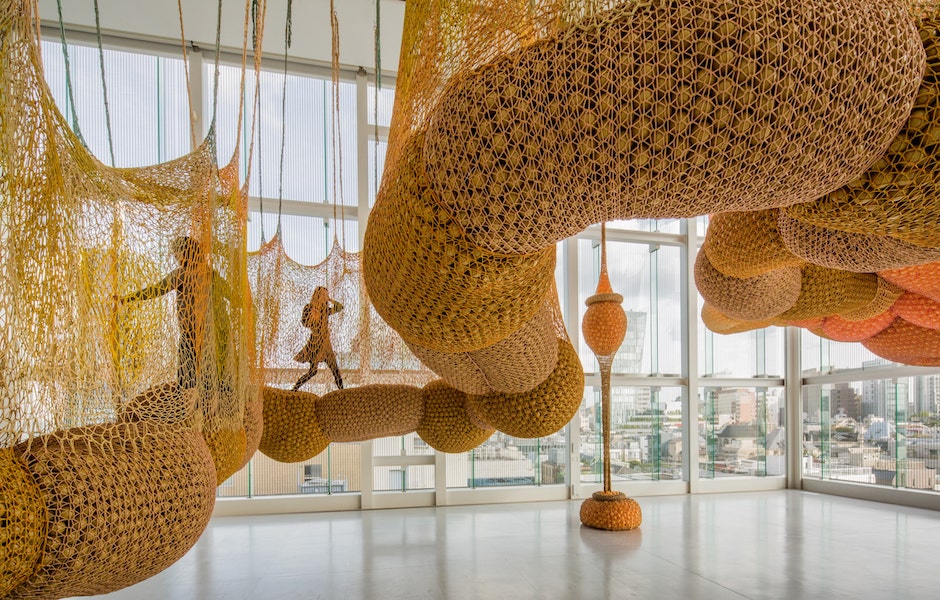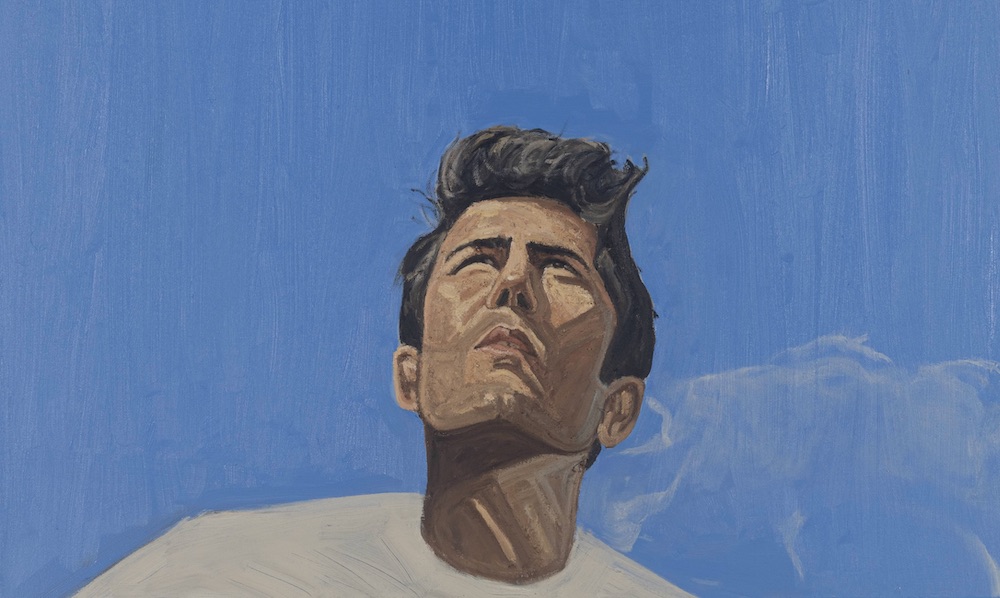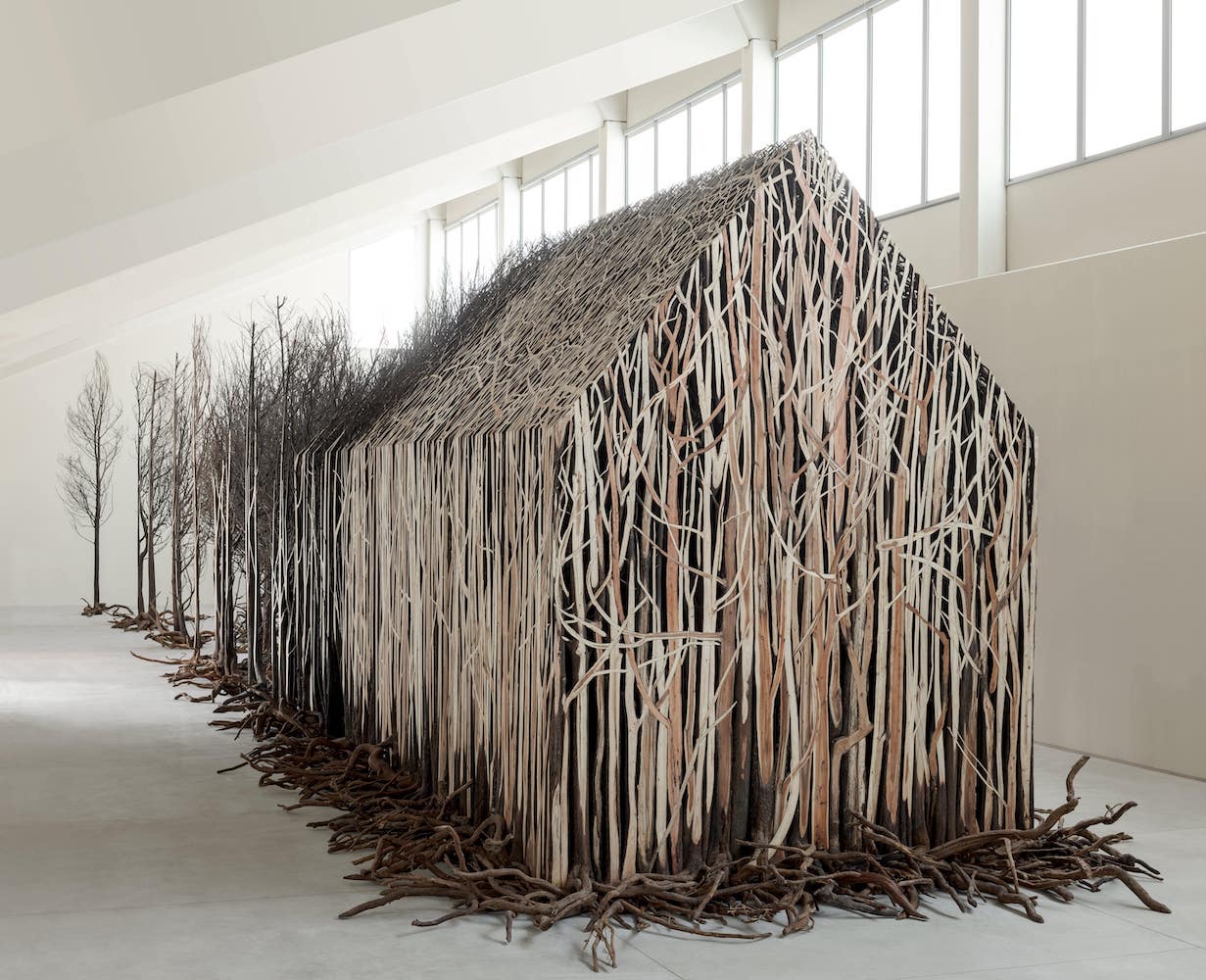Antonio Obá is always reading—a trait that became obvious when Whitewall recently asked him a few questions about his show “Outras águas / Other waters” at Mendes Wood DM, on view last winter in New York. He easily referenced ideas from literature, theory, and philosophy,
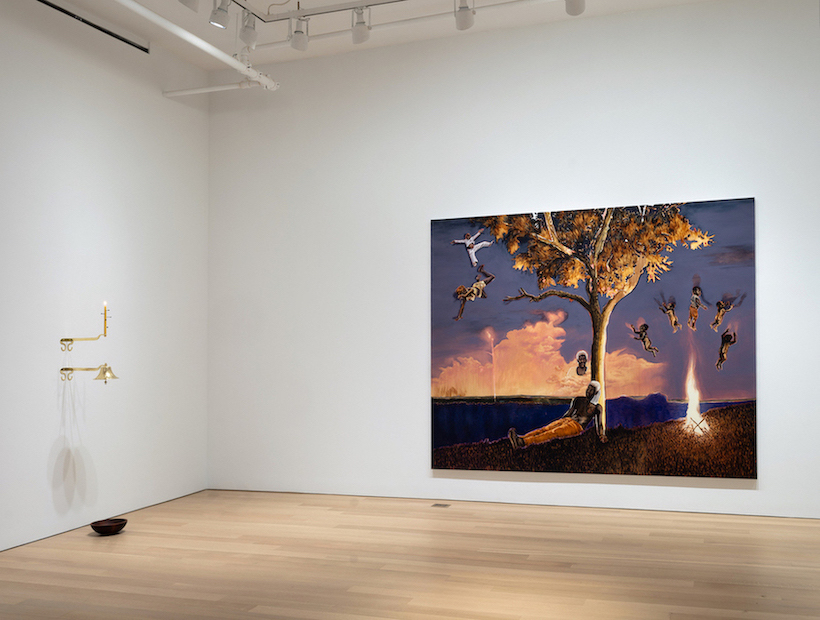 Installation view of “Anotonio Obá: Outras águas / Other waters” at Mendes Wood DM, New York (November 16, 2022—January 21, 2023), photo by Anita Goes, courtesy of the artist and Mendes Wood DM, São Paulo, Brussels and New York.
Installation view of “Anotonio Obá: Outras águas / Other waters” at Mendes Wood DM, New York (November 16, 2022—January 21, 2023), photo by Anita Goes, courtesy of the artist and Mendes Wood DM, São Paulo, Brussels and New York.
including writers like João Guimarães Rosa, whose 1962 book The Third Bank of the River served as a starting point for the exhibition. It tells a story of solitude, a man excluding himself from society to sail up and downriver. Being alone—with one’s self, thoughts, experiences, and process is part and parcel of his painting, the Brazilian artist shared with us. Being alone somewhere new—as he was in New York just before the opening to complete a few works—also offers a chance for things already within to come to the surface.
What arose in “Outras águas / Other waters” was an array of arresting images that are part allegory, dream, vision, and story. Several figures are depicted in repose, eyes closed—in a field, in a wood, or in a hammock with tears kissed by winged insects. In other paintings, a child leaps into a pool, a rider sits backwards on a horse with eyes that glow like the surrounding fireflies, and a figure draped in cloth stares straight back at the viewer.
In our conversation, Obá discussed how connecting with the rhythms of nature is indeed connecting with the rhythms of creativity, and why the condition of an eternal apprentice allows for an openness that brings meaning to life.
WHITEWALL: Some of these works were completed while you were working from a studio in New York. How did the location, your experience there, impact the work?
ANTONIO OBÁ: I went to New York with a very conscious idea of trying to take a bit of this land, this place where I live, this geography, this experience, this metaphysical experience with the land and with the sertão (the backlands) of Brazil. It’s no wonder that on this trip I took and reread João Guimarães Rosa’s O Grande Sertão Veredas, because I had this idea of constructing a narrative that would make mention of this enchanted character that exists and that I perceive a lot in the book. The situation of being outside evidently also reflects the whole production, the light, the environment, being alone—I spent a lot of time alone in the production of these works.
It is a very common experience for those who deal with art, which is our work material, and for this reason it should not be dependent on the place, be it familiar or foreign. The production and elaboration of the work does not depend exclusively on it. From the moment you become aware and independent of the narratives, of the propositions, certain things start to become clearer and more perceptive in this process. It is a process that starts a lot from this idea of bringing things to the surface and that many times are provoked by the very environment where I find myself and by the situation I am experiencing. What I mean is that being in another place precipitates new narratives that sometimes are already there in a latent way and that you access in one way or another through your openness. The most important thing in this whole issue is this condition of a certain openness of spirit, and, based on the experiences, you try to create something.
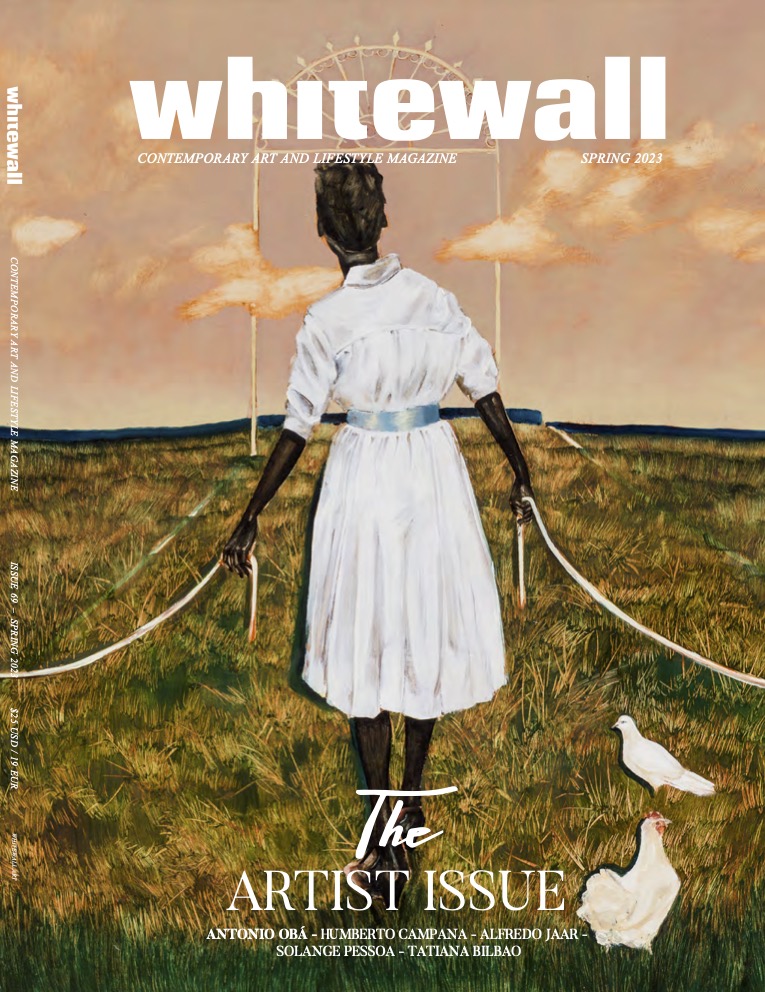 Antonio Obá, “Variação sobre Sankofa – Quem toma as rédeas abre caminhos (Variation on Sankofa – Whosoever takes the reins opens the paths),” 2021, oil on canvas, 27 1/2 x 23 5/8 inches, photo by Bruno Leão, courtesy of the artist and Mendes Wood DM, São Paulo, Brussels and New York.
Antonio Obá, “Variação sobre Sankofa – Quem toma as rédeas abre caminhos (Variation on Sankofa – Whosoever takes the reins opens the paths),” 2021, oil on canvas, 27 1/2 x 23 5/8 inches, photo by Bruno Leão, courtesy of the artist and Mendes Wood DM, São Paulo, Brussels and New York.
WW: A point of departure for the exhibition was João Guimarães Rosa’s The Third Bank of the River (1962). The story speaks to solitude as a return to the self—a search for the unknown in the quiet observation and conversation with nature. What role does solitude play in your artmaking?
AO: I believe that the pictorial process itself, or the painting process, conjures—at least for me—a feeling of solitude . . . of being alone, in silence, in constant observance of what I am doing effectively with the painting and of what is happening around me. Coincidentally, this idea
of the “third bank” contains an element of distancing, and there is a lot of the creative process within that: When you find yourself in a given place and time, in an act of observance, you keep a certain distance in order to better observe and observe yourself—it is almost a kind of imaginary anthropometric examination, which emanates from the state of solitude, of refrain and of restriction in order to bring to light previous experiences.
WW: And what role does nature play?
AO: Nature plays a role because we are part of it, and we are with it in one way or the other. It is part of who we are. It is quite surprising that nowadays this has almost been forgotten, up to point that it is regarded as something totally unimagined, whilst it is totally the opposite. I believe that there is a lot to do with an attempt to connect with a natural rhythm. Nature imposes its own rhythm in our existence and not the contrary. We are completely subordinate to the cadence of nature, and, for me, this physical aspect of nature, being in contact with animals, plants, with the wind, with the different colors that the earth takes on throughout the day. . . to allow yourself the time to observe and experience these rhythms, which are the rhythms of a creative process. A rumination.
Guimarães Rosa compared the creative process of literature to the process of rumination by cattle. It is not a quick process of nutrition. You must eat it, swallow it, ruminate. The creative process is the same. As you can see, I have chosen a natural metaphor to illustrate my idea, because for me it is extremely important to be in sync with nature in a way that it will allow me this special time to create, which is indeed slower.
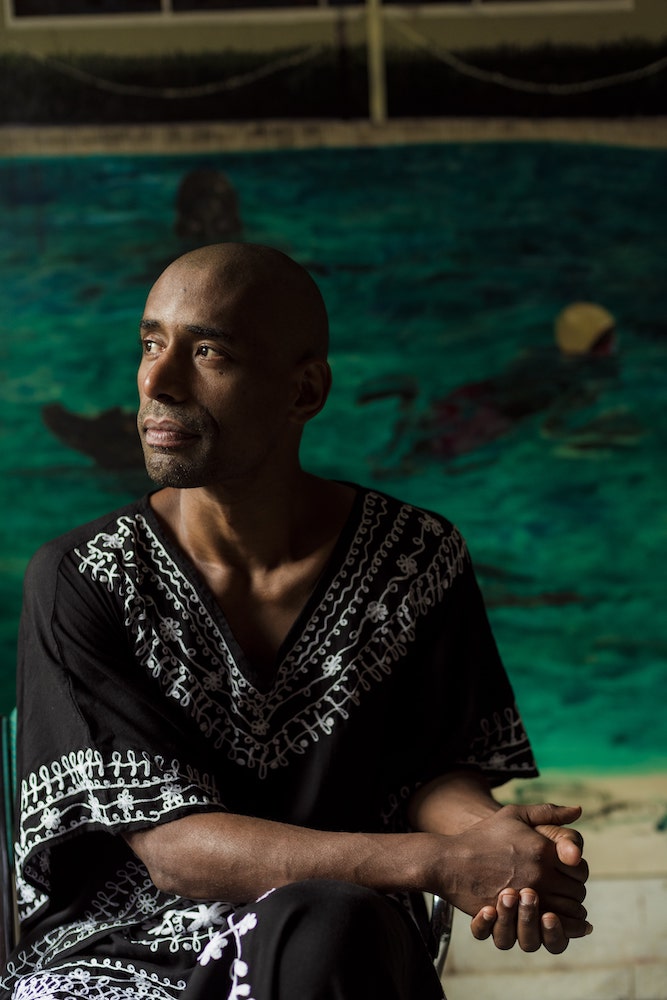 Antonio Obá, portrait by Diego Bresani.
Antonio Obá, portrait by Diego Bresani.
WW: Research, whether into history or your own origins, is something you’ve described as a starting point for you. What kind of research were doing with this body of work?
AO: In the exhibition “Outras águas,” the works presented respond to constant research threads of mine, which I refer to as a kind of intimate genealogy, but a genealogy that is also shared with the human condition and experience. I elaborate upon memories, fears, solitude—questions that are relevant to every human being. For me it is about that: attempting to converse through experiences that are mine, but that also resonate with those from others.
WW: Can you tell us about some of the symbolism we see in the paintings on view? Like the rainbow in Orev – pouso (Orev – landing) [2022]?
AO: The rainbow has a very direct relationship with what I was talking about nature, in the previous question. In a certain way it is a work that presents this idea of nature being a means of contact with the rhythms of the earth, as if it were a means of finding a very earthly sacredness. A mention I always make is of the book Leaves of Grass from Walt Whitman, which poses this question of the sacred, of metaphysics very rooted in the ground—very physical, very material, very present.
We have a character in this painting who is totally surrendered to the ground. He is lying down, barefoot, his feet dirty, denoting this character of a walker. It is nice to think of this figure of the walker when we imagine this metaphor of the path as a conductor of spirituality. And we have archetypes that denote this in a very strong way, as for example the Hermit card in the tarot, we have the very idea of the way of Santiago de Compostela—this monk who puts himself on the way as a reflection process and to reach a kind of contact with the divine. I believe that this work mentions this: this encounter with the earth as a metaphysical possibility that is well denoted with the presence of this rainbow, an almost supernatural presence . . . this rainbow that crosses this body, but that conditions this metaphysical experience as a concrete reality.
Light is material. Light is not without substance; it belongs to the world, to physical phenomena. It is material in this sense. One way I do to evoke this materiality of a light that is always something very distant, divine, and the way I do this is by placing a projected shadow of this rainbow on the ground. It is a work that evokes both this physical and spiritual dimension, amalgamated.
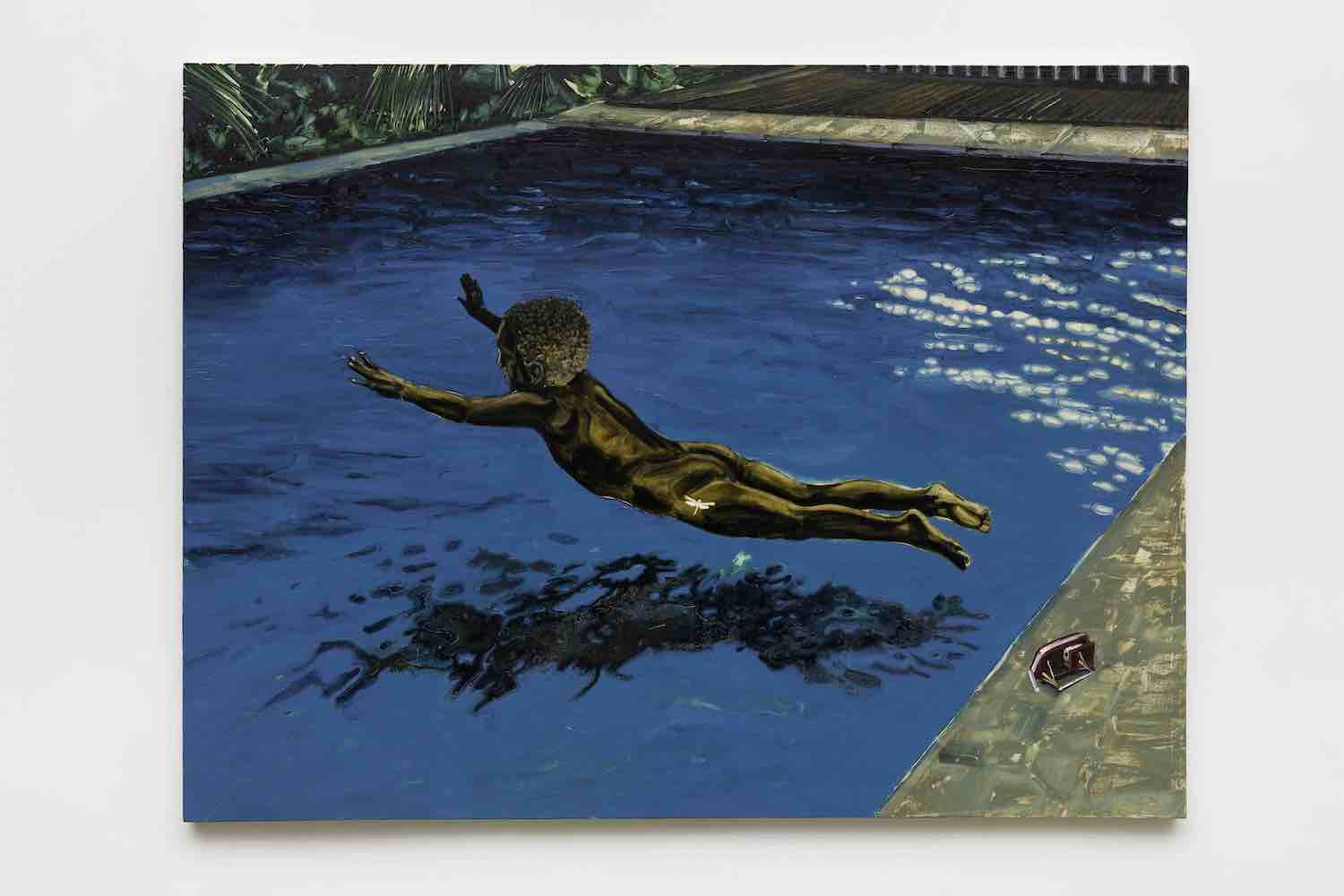 Antonio Obá, “Fata Morgana no1,” 2022, oil on canvas, 59 x 78 3/4 inches, photo by Bruno Leão, courtesy of the artist and Mendes Wood DM, São Paulo, Brussels and New York.
Antonio Obá, “Fata Morgana no1,” 2022, oil on canvas, 59 x 78 3/4 inches, photo by Bruno Leão, courtesy of the artist and Mendes Wood DM, São Paulo, Brussels and New York.
WW: And the moths fluttering from the eyelids in Encantaria – Gorgone Macarea [2022]?
AO: Encataria – Gorgona Macarea has this premise of being an autoreferential work. This one explicitly demarcates itself as a self-portrait, but I would say it has this characteristic of being more autoreferential. I talk about things, about my experiences, from an attempt to align these sensations with a human experience that connects all people. And in this case, it came from a sensation, of being alone, and alone in a new place, feeling, reliving memories, living the sensations. It came to me through researching this moth that feeds on the tears of other animals. It complements its nutrition from the salts of these tears.
And poetically, this is a beautiful image and metaphor of a transmutation that for me has a lot to do with the metaphysical transmutation, with the metaphysical fist that exists in the Brazilian
tradition of the Encantados, which has this characteristic of conceiving and explaining certain aspects that are limited to the human dimension, like death, for example. Not rarely do we have reports from the Encantados that a certain entity didn’t die, but became enchanted. It became a moon, an element. This is very reminiscent of a mythical conception of existence itself, where the body becomes this object of celebration, of promise, this conductor of this experience that goes beyond a secular or merely physical experience, but that through the body reaches this sacredness.
WW: You’ve spoken about not having a predefined idea of what will happen with a painting. You let it instead reveal itself. Where does a painting then begin for you?
AO: The answer is simpler than the question suggests, because, in fact, it is very important not to fall into that frivolity of thinking that out of nothing you get an idea to produce something. There is no such thing. Especially if you work with images, you are dealing with a wide repertoire, which you don’t even have a total precision of because it is part of an imaginary, this possibility and potential that we have to create images.
When we think of this on a scale that is potential, it already makes us realize that every creation process will generate surprises along the way. Why is that? Because you are dealing with a matter that is moving. It is one thing to imagine that you are going to paint, but it is another thing to deal with the clashes of reality itself: of the technical limit, of your own imagination that changes along the way. If you are attentive and experience that, suddenly a brushstroke, a color is not exactly what you were imagining, and you need to deal with that somehow.
So, for me, this is where the process of creation gets interesting. The part that breaks out of the script. I really like Barthes’s definition when he talks about the “punctum” of the image. When he says that an element of the image seizes you without you even knowing how. There is this dialogue with a memory, with a previously given imaginary, and there is your own experience that will always chain surprises. Because if there are no surprises, then the whole reason for being a creative process is lost. You start repeating yourself indefinitely. And that doesn’t appeal to me at all.
I find the idea of a painter having a style quite suspect. In general, I really like to think of a phrase sung by Paulinho da Viola in a song, “things are in the world, you just have to learn them.” That’s it for me. Within this process of creation and how I perceive where a work begins and ends, it goes a lot from a shrewd investigation within the very dynamics of this process of creation.
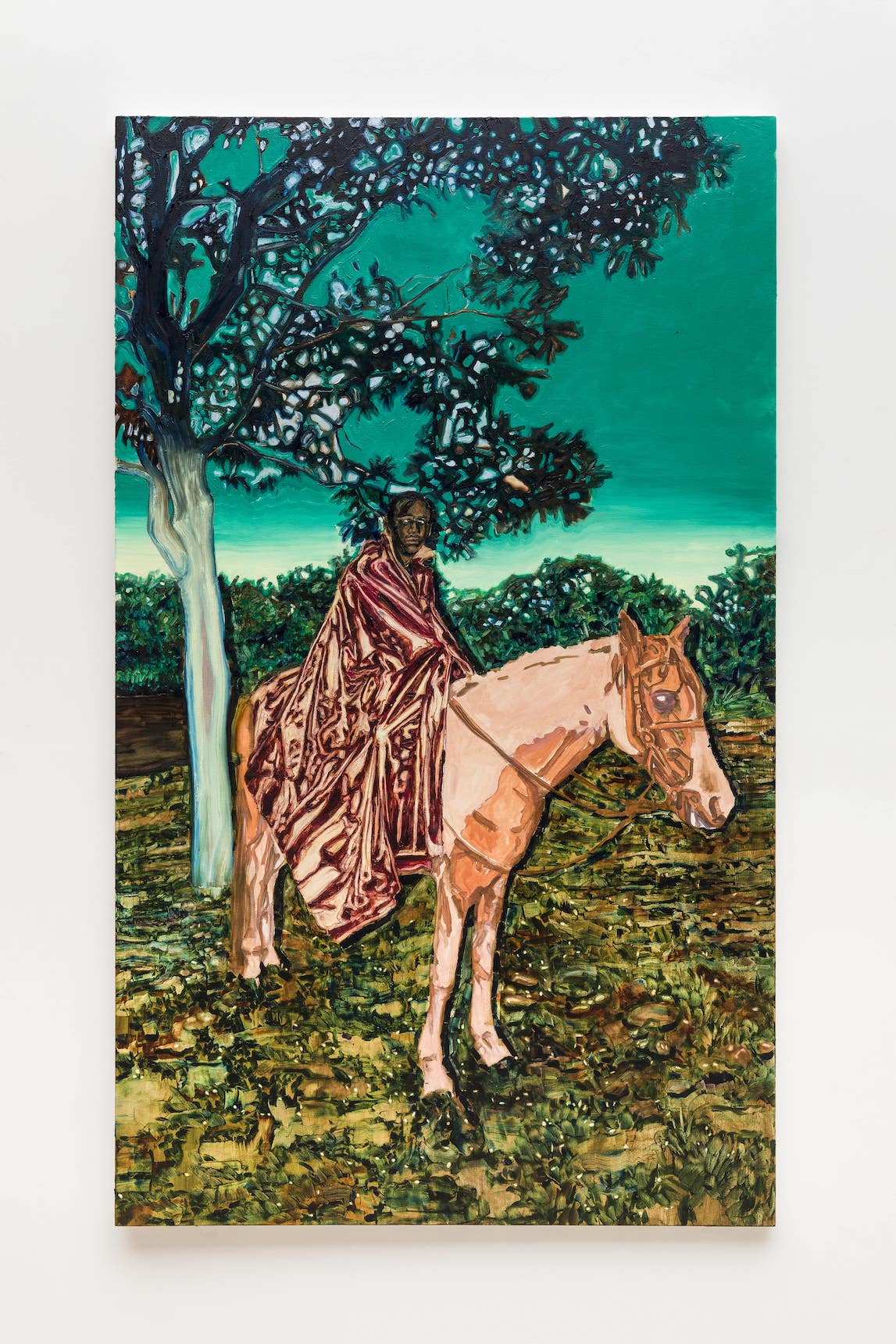 Antonio Obá, “um amálgama. Cavaleiro monge – ascendência (an amalgam. Horseman monk – ancestry),” 2022, oil on canvas,
82 5/8 x 49 1/4 inches, photo by Bruno Leão, courtesy of the artist and Mendes Wood DM, São Paulo, Brussels and New York.
Antonio Obá, “um amálgama. Cavaleiro monge – ascendência (an amalgam. Horseman monk – ancestry),” 2022, oil on canvas,
82 5/8 x 49 1/4 inches, photo by Bruno Leão, courtesy of the artist and Mendes Wood DM, São Paulo, Brussels and New York.
WW: So where does it end?
AO: This is a funny question. There is one thing that I have come to realize over time: Each painting is part of a great teaching, and sometimes, within the process of elaborating a work, especially a painting, there comes a moment when the work itself communicates “Don’t touch me anymore.” Then you interrupt the process and face your dramas in another way or another way. So I started to respect this more. So there is no point in messing with a work anymore, because it is a process that never ends. Because you are constantly learning new things from this process. If we think deeply: It doesn’t end. It is all a constant work in progress. A constant development.
WW: Does that final result ever surprise you? Or shift in your understanding of it as time goes on?
AO: It is one of the pillars of a work, of the relevance of a work. In a certain way, you can be surprised by it, even after a few years. And I think that the power of an image is exactly that. It is not exhausted; it does not end. In fact, it keeps creating roots in your observation, especially in other people’s observation, too, and obviously this changes your perception about the result of a work of art itself. Analyzing from this point of view, a work always surprises. And I am very happy when I can achieve this surprise, for example, in a work that initially I didn’t like and kept, and after a few years I end up revisiting certain elements and being surprised. And that’s it. The work requires time. To see it requires time not to see it.
WW: You’ve talked about the importance of having an open body, one that can better be a channel to receive. How do you tap into and maintain that openness?
AO: By constantly nurturing the processes. Nurturing the references. Studying: from the technical aspect to conceptual issues. I have my support channels and anchors that signify my work process. I am always reading, especially literature, but also more theoretical readings, listening to music, exercising the body. It is a condition of life, actually—the point where work is differentiated from craft. Work, above all in our contemporary materialistic conception, disregards the fulfillment of tasks. Craft encompasses a dimension of life itself: I am here to do this and I will try to condition myself integrally to be eternally indebted to this craft. And this quote comes precisely from Egberto Gismonti’s musical construction that talks about this: be a debtor of the craft that you perform. Place yourself in this condition of an eternal apprentice, because that is what will bring meaning to your life. That is very beautiful to think about as a kind of philosophy of life.
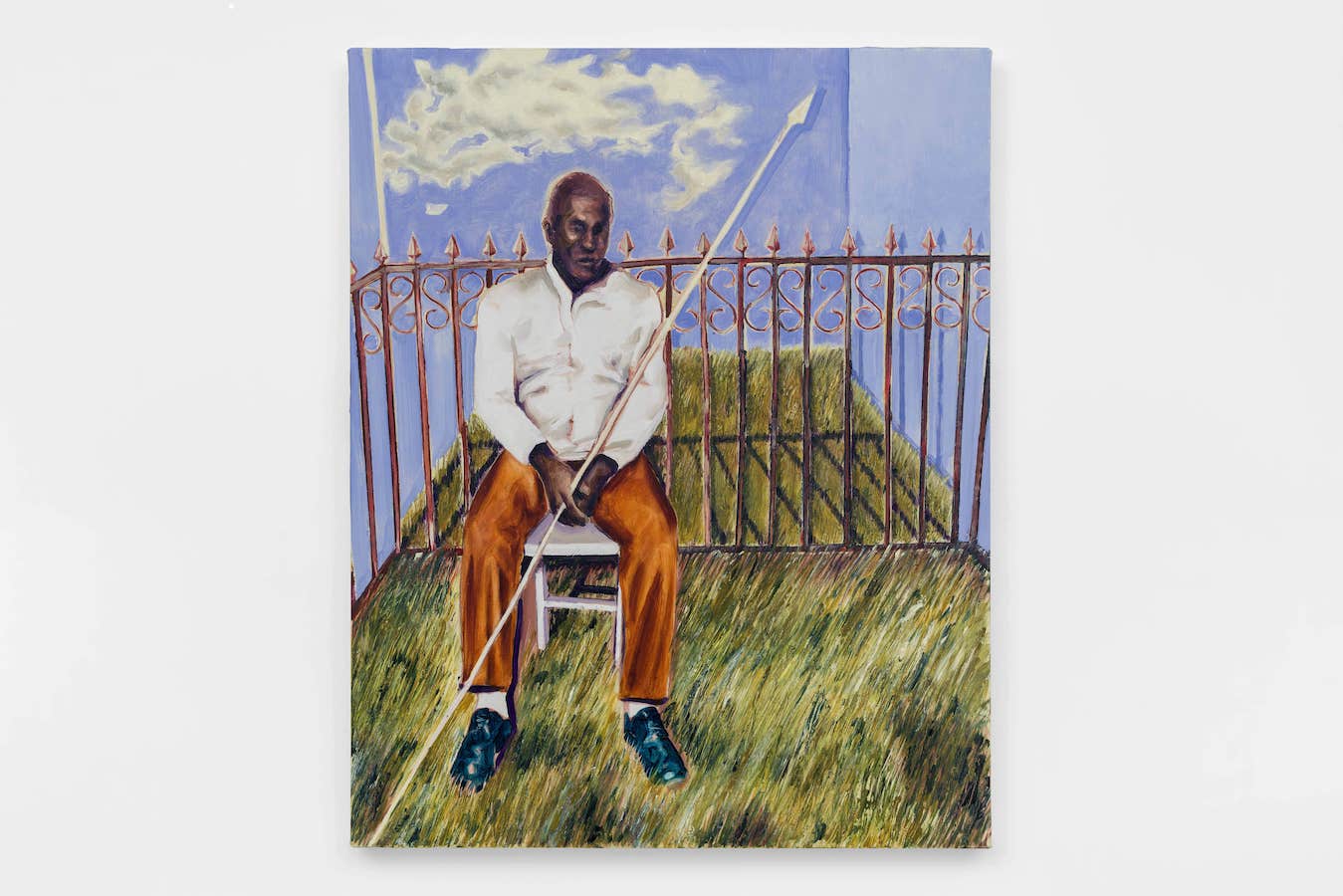 Antonio Obá, “Káwó – personagem guardião (Káwó – guardian character),” 2022, oil on canvas, 20 1/8 x 16 1/8 inches, photo by Bruno Leão, courtesy of the artist and Mendes Wood DM, São Paulo, Brussels and New York.
Antonio Obá, “Káwó – personagem guardião (Káwó – guardian character),” 2022, oil on canvas, 20 1/8 x 16 1/8 inches, photo by Bruno Leão, courtesy of the artist and Mendes Wood DM, São Paulo, Brussels and New York.
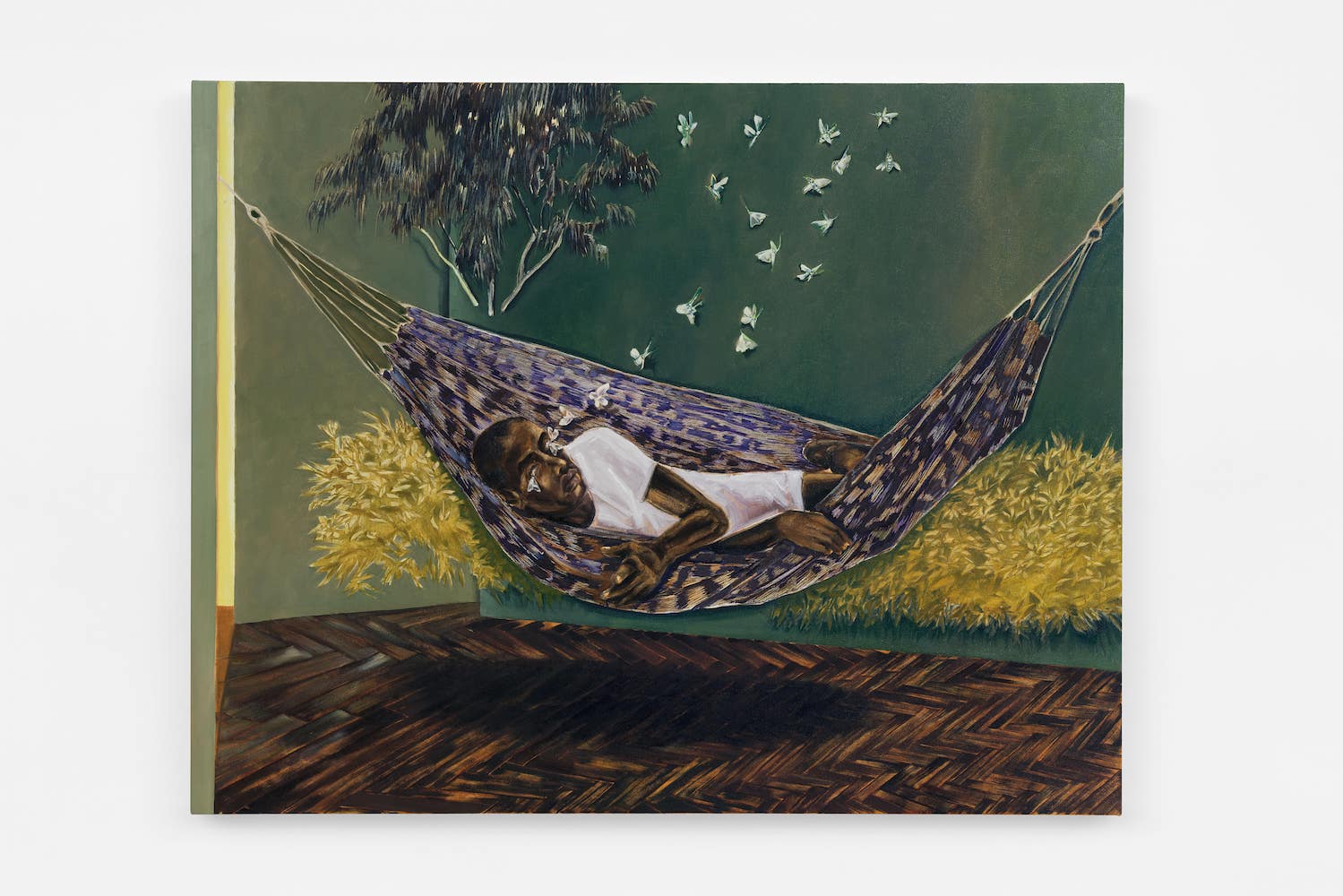 Antonio Obá, “Encantaria – Gorgone Macarea,” 2022, oil on canvas, 43 1/4 x 55 1/8 inches, photo by Bruno Leão, courtesy of the artist and Mendes Wood DM, São Paulo, Brussels and New York.
Antonio Obá, “Encantaria – Gorgone Macarea,” 2022, oil on canvas, 43 1/4 x 55 1/8 inches, photo by Bruno Leão, courtesy of the artist and Mendes Wood DM, São Paulo, Brussels and New York.







